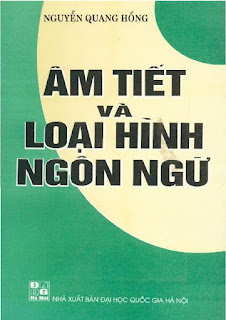PART 1 - OVERALL IMPRESSION ON "PHONEME AND LANGUAGE TYPOLOGY" BY NGUYEN QUANG HONG
OVERALL IMPRESSION ON THIS BOOK:
The preliminary remark does not serve as a summary of this book. I will do so in subsequent parts of my commentary and annotation. This is just an overview of my impression of the book.
Let me start by saying that this is a deep book that addresses many basic problems in linguistics. It provides me much information about concepts that I have been familiar with since college, but have not explored in any depth. As such, it holds a special place in my heart right now. I was introduced to this book by Dr. Nguyễn Đông Triều at the Social Science and Humanity University. I thank him for opening my eyes, not once, but many times during his lectures.
This book is a dense work by Dr. Nguyễn Quang Hồng, a linguist and philologist who were trained along the tradition of Soviet and socialist Chinese schools of linguistics. According to the title page of the book, Dr.Nguyễn Quang Hồng was born in 1939, in Trà Kiệu, Duy Xuyên, Quảng Nam province. He graduated as an undergraduate from the University of Beijing, specializing in Philology. He then proceeded to graduate from the Institute of Far Eastern Studies (Институ́т востокове́дения Росси́йской акаде́мии нау́к) as a "phó tiến sỹ" (кандидат наук-candidate in science). He defended his Phd in Philology from the Moscow State University (Московский государственный университет), also known as the Lomonosov University. He was active in the field of traditional Vietnamese philology and had a keen interest Nôm literature. He now serves as the Vice President of the Research Institute of Sino-Nôm. Judging from his publication history, this is perhaps his only book on linguistics as a broad field.
Up till reading this book, I have always taken for granted and never questioned the definition of a "phone" (音素-âm tố) and a "phoneme" (音位-âm vị). I was taught in China that a phone is simply the smallest unit of speech sound (a sound that fulfills all characteristics to be classified as a speech sound) and a phoneme is a more abstract construction in which a sound unit that can causes a difference in meaning of a word. A succinct definition of a phoneme is this:
音位是一個語音系統中能夠區別意義的最小語音單位
A phoneme is the smallest phonetical unit in a phonetical system that can differentiate meaning.
(現代漢語語音教程-北京大學出版社-2012年)
(A Course in modern Chinese phonetics-Beijing University-2012)
To be more specific. A phoneme is a set of different phones which can be defined as allophones. What are allophones? They are phones that are distinct from one another but do not cause a difference in meaning of a "word". A classic example of allophones is the phoneme /p/ in pile and speak. The phone [p] in pile is a aspirated plosive stop consonant, while the second is a unaspirated one. They are allophones because if you exchange them in each word, the meaning remains the same.
Dr.Nguyễn Quang Hồng, however, has shown, through the works of prominent Soviet linguists such as Bandouin de Coutenay and Lev Scherba (Лев Ще́рба) (1880-1944), that the concept of a phone and a phoneme is very complex. The major contention lies in how to divide a segment of speech (which in Dr. Hồng's terminology is a "flow of speech" (Ngữ lưu-語流) into phones and arrive at an acceptable definition, because the nature of our speeches is a stream of uninterrupted sounds that remain unanalyzed. Scherba contends that dividing speech segments into what we call phones does not just rely on their manner of articulation, but also on their function in defining meaning.
Moving on to the next unit of phonetics and phonology, which is syllable. How do we analyze and divide a segment of speech into syllables. The concept of syllable is certainly intuitive to most of us, without any special training in linguistics. For example, America can be divided into /A/+/ME/+/RI/+/CA/, in total, 4 syllables. It is quite intuitive to all who can speak English. Yet, the precise manner of "cutting" a word into syllables is certainly contentious, as there are many ways to do so. For example, Bombay, the name of a city in India, can be divided into /BOM/+/BAY/ or /BO/+/MBAY/. The structure is CVC+CVV versus CV+CCVV (with C stands for consonant and V for vowel). Which way is the way to go? This ambiguity in dividing a word into a syllable will plague all languages that can be classified as "inflectional". Yet, in languages such as Chinese (with almost all of its dialects, including Mandarin) and Vietnamese, the correspondence between a syllable at phonological level and a morpheme at morphological level is almost 1 to 1. This means that the task of dividing a word into syllables is much less problematic and almost free from any ambiguity. For example, "Cám ơn" in fast connected speech will be /CÁMƠN/, with liason occuring between "m" and "ơ". But it is clear that we cannot divide "cảm ơn" into /CẢ/+/MƠN/, because it has no meaning or signifies a different word. It is eye-opening to me. This is something I have not been taught in China.
The next interesting aspect is how two phonological traditions in Europe and China establish their most basic sound units. In Europe, it is clear that phones are chosen to be the sole candidate, whereas in China, it is syllable. This is also a mind-blowing difference that I have never come to realize. Upon reflecting on this, an insight hits me: the nature of Chinese characters ought to be taken into account. A Chinese character is represented by a syllable, not a phone, as in Latin or any Western writing system. As such, Chinese philologists might have to work within this constraint when developing phonological concepts for their native tongue.
INSIGHTS GAINED FROM THE BOOK
1) Overall, I really enjoy this book as it brings out many fundamental questions about the nature of the most basic units in phonetics and phonology.
2) I was introduced to many Russian and then Soviet linguists of which I have never known, and their works open a window into a different way of thinking about phonological concepts in linguistics.
3) I was also introduced to Chinese classical tradition of phonology, which is a field of which I was totally ignorant.
4) One of the greatest insights that Dr. Nguyen Quang Hong succinctly synthesies in this book are three principles of proceeding to conduct researches of a language, namely:
a) From the innermost: linguists who are native to the concerned language develop a system of concepts unique to that language in order to describe in the most complete way all of its facets (phonology, grammar, morphology, etc.) As a few examples that are or are not tacitly mentioned in the book, I can name, for instance, the concept of 聲母 (intial) and 韻母 (final) in classical Chinese phonology and the method of dissecting and distinguishing them called fanqie 反切. A less familiar example to me, yet still valid, is Arabic native grammatical concepts that reflect the inner working of Classical Arabic (this is not mentioned in the book because it lies outside its scope).
There is however, in my opinion, a less-than-ideal reality about this principle. Many languages of more primitive societies, noticeably languages of Native Indians in North America, are not fortunate enough to be subjected to any native linguistic traditions. As such, conducting researches into the nature of these languages requires a much more nuanced approach than what prescribed here. Within the scope of the book, I believe that Dr. Nguyen Quang Hong only thought of well-developed traditions of more influential languages when he wrote this book. I also believe that there is almost no systematic linguistical treatment borne from a tradition in my native land, Vietnam, which can describe Vietnamese prior to the arrival of European missionaries.
b) From the outermost into the inner core: linguists who are NOT native to that language apply concepts borrowed from their own native language(s) to conduct research into their non-native target. In doing so, they provide crucial insights that help to form a framework that leads to the third principle. As an example, Western priests who came to China and Vietnam began to apply various concepts borrowed from European classical linguistical traditions, which can originally be traced to Latin and Greek grammarians, to describe contemporary Chinese and Vietnamese.
c) From above: a fusion of both traditions above gives rise to the process of generalizing and forming a system of concepts that effectively enable crisp description of ALL languages. There is a limit of generality to this approach. However, it is very necessary take this step in order to form a broadly comparative analysis between languages, as well as language families.
Without doubt the book is a bit theoretical, and linguists or speech pathologists whose main concern is practical applications should not troubled to go through these subtleties. The book itself is very well laid out and does not confuse anybody, it is the subject that is hard and difficult to grasp. But there is no doubt that my foundational knowledge in linguistics have been strengthened after reading it.



Comments
Post a Comment